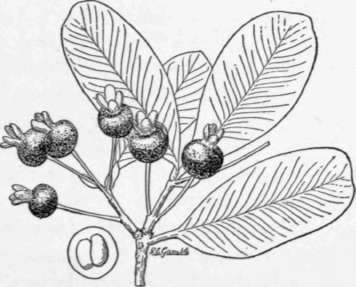From the Manual Of
Tropical And Subtropical Fruits
by Wilson Popenoe
The Grumichama
Eugenia Dombeyi
Skeels
This is a better fruit than several other species of Eugenia
which are much more widely grown. It is found both wild and cultivated
in southern Brazil, particularly in the states of Parana and Santa
Catharina. Elsewhere, with the exception of Hawaii, it is scarcely
known.
The tree, which grows to the same size as the orange, is
shapely and attractive in appearance, with ovate-elliptic, glossy, deep
green leaves 2 to 3 inches long. The small white flowers are followed
by pendent fruits, round or slightly flattened, the size of a cherry,
and deep crimson in color. The persistent green sepals which crown the
apex are a distinguishing characteristic. The skin is thin and
delicate; the flesh soft, melting, of a mild subacid flavor suggesting
that of a Bigarreau cherry.
The seeds are round or hemispherical
when one or two in number; sometimes there are three or more, in which
case the size is reduced and they are angular.
The rapidity with
which the fruits develop is surprising; within a month from the time of
flowering they have reached maturity and are falling to the ground.
Father Tavares states that all the trees do not ripen their crops at
the same time, some blooming later than others and thus extending the
fruiting season from November to February (in Brazil). Three varieties
are distinguished by him, one with dark red flesh, another with
vermilion, and the third with white. All three are said to be equally
good in quality. The fruit is usually eaten fresh, but may also be used
to make jams and preserves.
The grumichama (sometimes grumixama,
to conform to old Portuguese orthography) has recently been planted in
California and Florida. In the latter state it has withstood a
temperature of 26° without injury, which indicates that it is
subtropical, rather than strictly tropical, in character. It prefers a
deep sandy loam, but succeeds in Florida on shallow sandy soils.
Vaughan MacCaughey says: "In the Hawaiian islands it is usually about
20 feet high. It requires considerable moisture for its best
development, as do all the Eugenias
in our flora; the largest crops are borne by plants at the lower
levels, up to 300 feet . . . flowering and fruiting continues from July
until December, the main crop coming in the fall. . . . The first
plants in Hawaii were probably introduced by the Spaniard, Don
Francisco de Paula Marin, who came to the islands in 1791." The
grumichama is sometimes listed as Eugenia
brasiliensis, Lam. Stenocalyx
brasiliensis, Berg, is another synonym.

Fig. 39. The grumichama (Eugenia
Dombeyi),
a little-known fruit from southeastern Brazil
Seedlings
are said to commence fruiting when four or five years old. They grow
rather slowly. No one appears to have budded or grafted the species as
yet. For its value as an ornamental plant as well as for its pleasant
fruit, the grumichama deserves cultivation throughout the tropics and
subtropics.
Back to
Gruimichama
Page
|
|